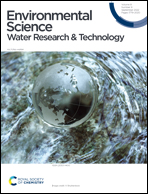Construction of a hetero-junction recyclable composite photocatalyst from aluminum-based waste/magnetite for efficient carbamate insecticide oxidation
Abstract
Twinning aluminum-based waste, namely alum sludge (AS) residues, with environmentally prepared magnetite, Fe3O4, nanoparticles (M) has been confirmed to exhibit higher performance than a pristine single-phase alum sludge photocatalyst or magnetite nanoparticles owing to the formation of a hetero-junction between the alum sludge and magnetite (called AS–M). In the current investigation, further promotion of photocatalytic activity of twinned (AS–M) was attained by coupling AS with magnetite nanoparticles via calcination at different weight proportions and the obtained samples were named AS–M-(1 : 1), AS–M-(2 : 1), AS–M-(3 : 1), AS–M-(5 : 1) and AS–M-(1 : 2). The structure, morphology and characteristics of the prepared samples were characterized using X-ray diffraction spectroscopy, transmission electron microscopy (TEM) and a scanning electron microscope (SEM). Also, the magnetic properties of the prepared samples were investigated with a vibrating sample magnetometer (VSM) and Fourier-transform infrared spectroscopy (FTIR) was conducted. The photocatalytic activity of the samples was checked through diffuse reflectance spectra (DRS). Then, the prepared samples were used to oxidize carbamate insecticide from aqueous effluent as a simulated agriculturally polluted stream. The experimental results revealed that the photocatalytic activity of the twinned AS–M enhanced the complete carbamate removal by shortening the reaction time and chemicals used compared to those of pristine AS and M treatments. The system parameters were investigated and the maximum carbamate oxidation reached 100% removal at pH 6.5 with 130 and 50 mg L−1 of H2O2 and catalyst, respectively using a Box–Behnken factorial design. The experimental results revealed that AS–M-(1 : 1) is an optimal twinned mixture under the optimal operating conditions. Thermodynamic parameters revealed that the reaction is exothermic and non-spontaneous in nature. The kinetic data confirms the reaction follows the second-order reaction kinetic model.



 Please wait while we load your content...
Please wait while we load your content...